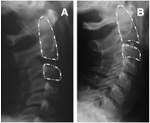Chronological age and cervical vertebral maturation among children and adolescents
Keywords:
cervical vertebral maturation, age determination based on skeletal development, cervical vertebrae, growth.Abstract
Introduction: the importance of distinguishing chronological from skeletal age or bone maturation has been recognized in medical, orthopedic and dental practice. Estimation of bone development on the basis of cervical vertebrae has proved to be a reliable method.
Objective: relate the stages of bone maturation based on cervical vertebral development as described by Baccetti to the chronological age of children and adolescents aged 8-14 years attending a dental clinic.
Methods: probabilistic sampling was used to select 130 children from the city of Cali, Colombia. Lateral skull radiography was performed to evaluate the stages of cervical vertebral bone maturation using the method described by Baccetti.
Results: the correlation coefficient between chronological age and cervical maturation stage was r= 0.69, showing a moderate relationship between the two variables for the children studied. Maturation stages and gender accounted for 50.4 % of the variability in chronological age. Significant differences were found for all maturation stages (p< 0.001). Boys had higher initial maturation stages, though significant differences were not found between the genders (p> 0.05).
Conclusions: It is possible to determine a model to explain the change in chronological age depending on the stage of cervical bone maturation and sex of the child, based on moderate positive relationship between chronological age and bone maturation evidenced through C3 stadium.
Downloads

Published
How to Cite
Issue
Section
License
Authors retain all rights to their works, which they can reproduce and distribute as long as they cite the primary source of publication.
The Rev Cubana Estomatol is subject to the Creative Commons Attribution-Non-Commercial 4.0 International License (CC BY-NC 4.0) and follows the publication model of SciELO Publishing Schema (SciELO PS) for publication in XML format.
You are free to:
- Share — copy and redistribute the material in any medium or format.
- Adapt — remix, transform, and build upon the material.
The licensor cannot revoke these freedoms as long as you follow the license terms.
Under the following terms:
Attribution — You must give appropriate credit, provide a link to the license, and indicate if changes were made. You may do so in any reasonable manner, but not in any way that suggests the licensor endorses you or your use.
- NonCommercial — You may not use the material for commercial purposes.
No additional restrictions — You may not apply legal terms or technological measures that legally restrict others from doing anything the license permits.
Notices:
- You do not have to comply with the license for elements of the material in the public domain or where your use is permitted by an applicable exception or limitation.
- No warranties are given. The license may not give you all of the permissions necessary for your intended use. For example, other rights such as publicity, privacy, or moral rights may limit how you use the material.

